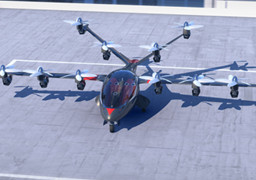




 |
 |
 |
|||
 |
 |
 |
 |
 | |
 |
 |
 | |


| 미디어 브리핑스 | 내서재담기 |


  |
 |  |
디지털 혁명은 도시 지상 교통의 대변혁을 예고하고 있다. 현재의 교통 체증을 해결할 효과적 대안이 등장하는 것이다. 아직 개발 초기 단계이긴 하지만 개인용 비행 자동차가 모습을 드러내고 있다. 이러한 대안은 경제적으로 타당할 것인가? 실제 운행이 활성화되기 위한 마지막 퍼즐 조각은 무엇이며, 이로 인해 어떤 기회가 창출될 것인가?
50년도 더 된 허구의 <젯슨 가족Jetsons>(1960년대 방영된 TV만화, 우주의 자동화된 주택에 사는 젯슨 가족을 중심으로 벌어지는 일상 이야기를 담은 애니메이션)이 보여줬던 21세기 세상이 어느새 우리 곁에 현실로 다가온 듯 보인다. 효율적 비용으로 이용이 가능한 서비스 로봇이 향후 20년 내에 노인 진료나 위기 상황에 집중 투입되고, 공중을 날아서 출퇴근그런 세상 말이다. NASA의 새로운 연구에 따르면, 수직이착륙하는 에어 택시air taxi가 현재의 ‘우버Uber’만큼이나 저렴해질 수 있으며, 이전에 비해 3분의 1도 채 되지 않는 시간에 목적지까지 탑승자를 데려다줄 수 있다고 한다. 실제로 우버와 같은 ‘주문형 이동 비즈니스 모델’과 ‘최첨단 드론 기술’이 결합한다면 향후 경제를 움직이는 최상의 모델이 될 것이다.
‘NASA 랭글리 연구 센터’의 온디맨드 모빌리티On-Demand Mobility 부문 최고기술자 마크 무어Mark Moore는 최근 시애틀에서 열린 ‘SAE 항공 박람회’ 프레젠테이션에서 “우버는 진정한 도어 투 도어door-to-door 시스템을 제공할 수 있었다. 이러한 경제 모델은 거의 실패하지 않는다.”고 말했다. 무어의 프레젠테이션은 자동차형 비행기, 하이브리드 에어 시스템, 에어 택시 등으로 알려져 있는 ‘하늘을 나는 자동차’에 관한 현황 보고서의 일환이었다.
무어와 그의 동료들은 실리콘 밸리를 중심으로 오클랜드에서 산호세San Jose까지 이동하는 시나리오를 분석했다. 이 환경에서 에어 택시는 도심 지역을 1마일 당 1.5달러의 요금에 평균 34마일의 속도로 운행할 수 있다. 꽤 느리다고 생각할 수 있지만, 실리콘 밸리의 혼잡한 시간대 평균 주행속도에 비하면 250%나 향상된 것과 같다. 이동구간이 더 길어져 비행기가 고도 2,500피트에서 5,500피트에 이르게 되면 시간당 120마일에서 200마일 이상의 속도도 가능하다고 한다.
이러한 혁명적인 시스템이 어떻게 실제로 가능할까? 다음의 7가지 핵심적 전제가 필요하다.
1. 이 연구는 전기 구동 프로펠러로 움직이는 새로운 종류의 수직 이착륙 항공기 개발이 필요하다고 가정한다. ‘분산형 전기 추진제DEP’로 불리는 이 기술은 이미 ‘NASA 리프텍LEAPTech 계획’의 일환으로 초기 모델이 제작되고 있으며 다양한 상업용 개발이 이루어지고 있다.
2. 충분한 비행거리를 위해 현재 상업용으로 사용되는 것보다 에너지 밀도가 최소 2배가 넘는, 킬로그램 당 약 400와트시watt-hour 정도인 차세대 배터리 사용을 가정했다. 2016년 영국 기업 ‘옥시스OXIS’는 ‘리튬서퍼Lithium sulphur’ 기술을 토대로 한 배터리를 생산하기 시작했는데, 상당히 매력적인 가격대에 이 요구사항을 충족시킬 것으로 예상된다.
3. 이 ‘우버 에어’ 비행기가 운행하기 위해서는 이착륙 시설이 필요하다. NASA 연구는 대도시 건물 옥상, 고속도로 인터체인지 중앙, 심지어 떠 있는 바지선에 헬리콥터 이착륙장을 마련하자고 제안한다. 연구진은 기초조사연구 대상인 실리콘 밸리 지역에 이착륙장을 위한 인터체인지 공간이 적어도 200곳은 될 것이라 예상했다.
4. 미국 연방항공국이 새로 추가된 비행기에 관한 규정을 승인해야 한다. NASA 연구는 기존 헬리콥터 이착륙장을 미국 연방항공국의 이착륙 허가 규제에 맞게 사용할 수 있을 것으로 확신했다.
5. 비용을 최소화하기 위해, NASA 모델은 조종사 1명과 승객 1명을 태울 수 있는 비행기를 가정한다. 1인 승객 모델은 현재 우버가 운행하는 주행거리의 70% 이상, 그리고 다른 수단을 이용하는 통근거리의 80% 가량을 운행한다. 단, 조종사 자리는 앞으로 필요 없을 수 있다. 이미 조종사 없는 자율주행 비행기를 위한 기술이 존재하며, 기술적으로는 무인주행 자동차보다 훨씬 단순하다.
6. 경제적 타당성이 우버 스타일 비즈니스 모델의 핵심이다. NASA의 연구는 에어 택시 1대가 매년 1,500시간, 1주일에 대략 30시간을 비행할 것으로 추정한다. 그렇게 되면 시속 34마일의 경우 비용은 1마일당 1.5달러 이하로 낮아지게 된다. 이는 연간 총 비용으로 계산하면 7만 6,500달러에 해당하는데, 무인 자율주행 비행기에 적절한 수준이다.
7. 무어에 의하면 소음 규제가 통근용 에어 택시에 있어 ‘가장 골치 아픈 제약’이다. 만약 그런 차세대 항공기가 지금의 비행기나 헬리콥터처럼 시끄럽다면 이 아이디어는 무용지물이 될 것이다. 하지만 NASA는 분산형 전기 추진제로 움직이는 비행기용 모터가 소음 문제를 해결할 수 있을 것이라고 말한다. 마치 잡음 제거 헤드폰과 같은 원리다.
NASA는 이미 분산형 전기 추진체 기술을 개발해 시연하고 있다. 하지만 이 기술의 상용화는 조비 에비에이션Joby Aviation과 이볼로e-volo와 같은 민간 벤처기업에 달려 있다. 조비 에비에이션의 S2 항공기 디자인은 에어 택시 개념을 실현하는 데 필요한 모든 특징을 담고 있다. 이착륙 시 소음과 안정성, 에너지 문제가 발생하기 때문에 조비는 S2 설계에 12개의 접이식 프로펠러를 장착했다. 프로펠러는 수직 이착륙을 위해 전기 모터를 사용한다. 일단 순항 고도에 도달하면, 3개의 추진 프로펠러만 가동하면 된다. 지난 10년 동안 다이렉트 드라이브 전기 모터와 효율적인 모터 컨트롤러가 급속히 발전한 덕에, 가볍고 강력하며 믿을 만한 모터는 자가용 전기비행기의 꿈을 현실로 이루어주는 추진력을 제공할 것이다. 조비에 따르면, 스마트폰용으로 개발된 이중 제어 시스템과 센서 기술이 자동차보다 더욱 안전하게 사람들을 수송할 수 있는 전기 수직이착륙 비행기 제작을 가능하게 한다고 한다. 그렇게 되면 조비는 리튬 니켈-코발트 망간-옥사이드 배터리를 사용할 계획이다.
한편, 이볼로의 ‘EC200 볼로콥터Volocopter’는 독일에서 제작한 혁신적인 2인승 비행기다. 조비의 비행기보다는 덜 정교하며, 흡사 아이들 장난감을 크게 키운 것 같이 보인다. 하지만 이 비행기는 이미 예비 모델이 비행 가능한 상황이다. 18개의 독립적인 회전날개가 달린 EC200은 일반 헬리콥터보다 더욱 안전하고 단순하며 친환경적이다.
고도 6,600피트에 이르면 시간당 100킬로미터의 속도로 비행을 할 수 있으며 항속거리도 100킬로미터가 넘는다. 볼로콥터의 향후 버전은 속도와 항속거리가 더 빨라지고 길어질 것으로 기대된다.
이러한 에어 택시 서비스의 경제적 활용 모델에 관해 무어는 <긱와이어GeekWire>지를 통해 브리티시 컬럼비아British Columbia의 ‘헬리젯Helijet’이 이미 밴쿠버에서 빅토리아를 오가는 서비스를 개시했음을 밝혔다. 또한 실리콘 밸리처럼 점점 혼잡해지는 시애틀 지역이야말로 차세대 에어 택시가 필요한 곳이라고 말했다. 두 경우 모두 심각한 지형적 제약이 있어서 에어 택시 같은 해결책이 필요하다. 더불어 두 지역의 수많은 부유 소비층과 높은 주거비, 그리고 화창한 날씨도 에어 택시가 운행되기에 적절한 조건이다.
이러한 기술과 발전 속도를 감안할 때, 에어 택시 산업의 전망은 어떠할까?
첫째, 자동차와 통근 열차가 그랬듯이 에어 택시 산업은 디지털 기술-경제 시대의 혁명을 상징하게 될 것이다.
이것이 가능한 이유는 가벼운 소재, 정확한 GPS, 고성능 전기자동차, 소음제거 기술, 저렴한 센서, 인공지능 기반 제어 시스템 등이 공유 경제와 융합된 덕분이다.
둘째, 에어 택시 산업에 필요한 기술의 등장은 사회에 최대의 이익을 주려면 어디에 정부 지출이 이뤄져야 하는지를 입증하고 있다.
NASA 리프텍의 전기 추진체 계획과 독일 정부의 볼로콥터 연구에 대한 후원은 정부의 연구 자금 지원이 왜 중요한지를 설명해준다.
셋째, 차세대 배터리가 에어 택시 산업의 관건이긴 하지만, 현재의 미비한 개발수준이 해당 산업을 멈출 정도로 대단한 장애물이 되진 않을 것이다.
중량 대비 전력 성능이 월등한 연료전지 기술이 이미 존재하며 조만간 혼다와 도요타 모두 이 기술을 적용한 엔진을 대량생산할 것이다. 이에 쓰일 수소는 액체, 압축가스 형태로 저장할 수 있으며, 혹은 단순히 메탄올에서 추출할 수도 있다. 청정에너지 측면에서도 새로운 저비용 촉매제가 곧 햇빛과 물을 통해 효과적인 비용으로 수소를 발생시킬 수 있을 것이다.
넷째, 2030년이 되면 합리적 비용의 에어 택시 서비스가 수천만 OECD 회원국 국민들의 출퇴근 모습을 극적으로 바꿀 것이다.
도로에서 허비되는 수십억 시간이 레저 등 보다 생산적인 활동에 활용될 수 있다. 더 이상 도로 위에서 교통 정체는 증가하지 않을 것이며, 사람들은 상쾌한 기분으로 직장에 도착해 일에 집중할 수 있을 것이다.
* *
References List :
1. Business Insider, September 14, 2015, “A NASA Study Says ‘Air Taxis’ Could Be the Uber of the Future,” by Alan Boyle, Geekwire. ⓒ 2015 Business Insider, Inc. All rights reserved.
http://www.businessinsider.com/nasa-study-says-air-taxis-uber-of-future-2015-9?pundits_only=0&get_all_comments=1&no_reply_filter=1
2. Daily Mail, May 5, 2014, “The Future of Flight?” by Sarah Griffiths. ⓒ 2014 Associated Newspapers Ltd. All rights reserved.
http://www.dailymail.co.uk/sciencetech/article-2618915/The-future-flight-Helicopter-plane-hybrid-battery-powered-doesnt-need-runway-takes-VERTICALLY.html
3. Wired, June 22, 2015, “The 18-Rotor Volocopter Is Like a Flying Car, but Better,” by Mary Grady. ⓒ 2015 Conde Nast. All rights reserved.
http://www.wired.com/2015/06/18-rotor-volocopter-like-flying-car-better/
4. GeekWire, September 24, 2015, “NASA Study: Flying Air Taxis Could Be as Cheap as an Uber Ride, and Faster,” by Alan Boyle. ⓒ 2015 GeekWire, LLC. All rights reserved.
http://www.geekwire.com/2015/nasa-study-flying-air-taxis-could-be-as-cheap-as-an-uber-ride-and-faster/
 |  |
Urban Mobility Takes Off
Suddenly, the 21st century world envisioned more than fifty years ago for the fictional Jetsons family seems closer than anyone imagined. While cost-effective service robots will probably be focused on eldercare and hazardous situations for the next twenty years, commuters could end up flying to and from their jobs much sooner.
According to a new NASA concept study, taking a ride in a vertical-takeoff-and-landing (VTOL) air taxi could become as cheap as taking an Uber ride, and get you where you’re going in less than one-third of the time.1
In fact, it’s the combination of an Uber-like ride-on-demand business model with state-of-the-art drone technology that just might provide the best model for making the economics work.
As Mark Moore, chief technologist for on-demand ?mobility at NASA’s Langley Research Center observed during a presentation at the recent SAE AeroTech Congress and Exhibition in Seattle, “Uber could provide a true door-to-door system. It’s hard to beat that economic model.”
Moore’s presentation was part of a status report on “flying cars,” also known as roadable aircraft, hybrid air systems, or air taxis.
Moore and his colleagues analyzed scenarios focused on Silicon Valley and extending from Oakland to San Jose. In this environment, air taxis could realistically match an Uber benchmark of $1.50 per mile traveled at an average ground-speed travel rate of 34 miles per hour for urban areas. While that still sounds slow, it equates to a 250 percent improvement over the average Silicon Valley rush-hour travel speed.
For longer trips, passengers will benefit from cruising at 120 to 200 miles per hour or more once the vehicle reaches an altitude of 2,500 to 5,500 feet.
How would this revolutionary system actually work? Here are seven key assumptions:
1. The study assumes the development of a new kind of vertical-takeoff-and-landing aircraft, powered by electrically driven propellers. This so-called “distributed electric propulsion” (DEP) technology is already being prototyped as part of NASA’s LEAPTech initiative. It’s also being explored by an assortment of commercial ventures.
2. To provide enough range, the study assumed the aircraft would use next-generation batteries with at least twice the energy density that’s currently commercially available - around 400 watt-hours per kilogram. In 2016, the British firm, OXIS, plans to start producing batteries based on lithium-sulphur technology, which are expected to meet this requirement at a very attractive price point.
3. There’d have to be a takeoff and landing infrastructure to support all those “Uber Air” flights. The NASA study suggests putting helipads on the roofs of urban buildings, in the middle of highway cloverleafs, or even on floating barges. Researchers estimate that there’s room for at least 200 cloverleaf pads in the Silicon Valley region targeted in the preliminary research.
4. The Federal Aviation Administration would have to sign off on regulations for all those added flights. NASA’s study confirmed that the helipads could be built to fit the FAA’s clearance restrictions.
5. To minimize costs, NASA’s model calls for aircraft capable of carrying a pilot and one passenger. That single passenger model describes more than 70 percent of the trips currently conducted by Uber, as well as about 80 percent of other commutes. But notably, the pilot is likely to be optional; UAV technology already exists for autonomous vehicles without pilots, and it’s technically much simpler than a self-driving automobile.
6. The Uber-style business model is key to making the economics work: NASA’s study assumes that each air taxi would be in the air 1,500 hours a year, or roughly thirty hours per week. That brings the cost down to $1.50 per mile at 34 miles per hour. This equates to a total ownership cost of $76,500 per year, which makes sense for a pilotless autonomous vehicle.
7. Moore said the noise factor is the “most severe constraint” for commuter air taxis. If those next-generation aircraft are as loud as present-day airplanes or helicopters, the idea literally won’t fly. However, NASA says the motors for an aircraft powered by distributed electric propulsion could be arranged to create acoustic interference, resulting in low noise levels. It’s the same concept that makes today’s noise-canceling headphones possible.
NASA is already developing and demonstrating DEP technology. However, commercializing the concept will be left to private ventures such as Joby Aviation and e-volo. Let’s consider the latest innovations from these two firms.
Joby Aviation’s S2 aircraft design embodies all the characteristics needed to realize the air taxi concept. Since the primary noise, safety, and energy issues arise during takeoff and landing, Joby has incorporated twelve retractable propellers into the S2’s design.2
The propellers are powered by electric motors for vertical takeoff and landing. Once at cruise altitude, the S2 uses just three pusher-props.
Rapid progress over the past decade in direct-drive electric motors and efficient motor controllers has resulted in light, powerful, and reliable motors that will provide the propulsion to make the dream of personal electric aircraft a reality.
According to Joby, redundant control systems and sensor technology developed for smart phones make it possible to build a robust electric VTOL aircraft capable of transporting people more safely than an automobile. At this point, Joby plans to use lithium nickel-cobalt manganese-oxide batteries.
Meanwhile, e-volo’s EC200 Volocopter is a revolutionary two-person air vehicle from Germany.3 It’s less sophisticated than Joby’s, resembling a scaled-up children’s toy.
But it has the advantage of already flying as a prototype. With eighteen independent electric rotors, the EC200 is safer, simpler, and cleaner than normal helicopters.
At an altitude of 6,600 feet, it reaches a cruising speed of 100 kilometers per hour and has a range of over 100 kilometers. Future versions of the Volocopter are expected to achieve higher speeds and longer ranges.
When it comes to the economic model for such air taxi services, Moore told Geekwire that British Columbia’s Helijet is already blazing a trail with its Vancouver-to-Victoria service. He said that, like Silicon Valley, the increasingly congested Seattle region is especially well suited for next-generation air taxis.4
Both areas have severe geographic water and ground constraints that are easily circumvented with aerial solutions, as well as lots of affluent consumers, high housing costs, and good weather.
Given this trend, we offer the following forecasts for your consideration:
First, the air taxi industry will come to symbolize the Digital Techno-Economic Revolution just as automobile taxis and commuter trains symbolized earlier revolutions.
This concept is only practical now because of the convergence of the sharing economy with lightweight materials, precision GPS, high-performance electric motors, noise-canceling technology, inexpensive sensors, and AI-based control systems.
Second, the emergence of the technologies needed for the air taxi industry demonstrates where government spending can provide maximum value to society.
NASA’s LEAPTech Direct Electric Propulsion initiative and Germany’s sponsorship of critical work on the Volocopter illustrate why research funding is a crucial activity that we can’t afford to eliminate even as we redefine the role of the federal government (as discussed in our first trend this month).
Third, while it appears that next-generation batteries will meet the needs of the air taxi industry, shortfalls in this area will not be showstoppers.
Fuel-cell technology with far better power-to-weight performance already exists, and both Honda and Toyota will be mass-producing such power plants, shortly. Hydrogen for this purpose could be stored as a liquid, compressed gas, or simply reformed on-board from methanol. From a clean energy perspective, new low-cost catalysts will soon make hydrogen generation from sunlight and water cost effective.
Fourth, cost-effective air taxi service will dramatically impact commuting for tens of millions of people in the OECD by 2030.
Each year, billions of frustrating person-hours will be transformed into productive work time as well as leisure. Increased highway congestion will be avoided. People will arrive at work more refreshed and ready to maximize their contributions.
References
1. Business Insider, September 14, 2015, “A NASA Study Says ‘Air Taxis’ Could Be the Uber of the Future,” by Alan Boyle, Geekwire. ⓒ 2015 Business Insider, Inc. All rights reserved.
2. Daily Mail, May 5, 2014, “The Future of Flight?” by Sarah Griffiths. ⓒ 2014 Associated Newspapers Ltd. All rights reserved
3. Wired, June 22, 2015, “The 18-Rotor Volocopter Is Like a Flying Car, but Better,” by Mary Grady. ⓒ 2015 Conde Nast. All rights reserved.
http://www.wired.com/2015/06/18-rotor-volocopter-like-flying-car-better/
4. GeekWire, September 24, 2015, “NASA Study: Flying Air Taxis Could Be as Cheap as an Uber Ride, and Faster,” by Alan Boyle. ⓒ 2015 GeekWire, LLC. All rights reserved.
